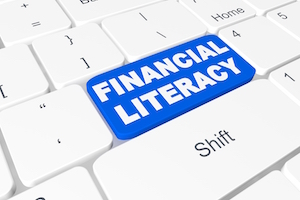 While financial well-being is a goal shared across society, more U.S. adults have a very low level of financial literacy than in any year since 2017, says an annual study that assesses overall financial literacy across the U.S. adult population.
While financial well-being is a goal shared across society, more U.S. adults have a very low level of financial literacy than in any year since 2017, says an annual study that assesses overall financial literacy across the U.S. adult population.
In fact, financial literacy tends to be low within each of the five generations comprising the U.S. adult population, but particularly so among those in early adulthood, according to the 6th Annual Personal Finance (P-Fin) Index by the TIAA Institute and the Global Financial Literacy Excellence Center (GFLEC) at the George Washington University School of Business.
On average, U.S. adults correctly answered only 50% of the P-Fin Index questions in 2022—a figure that has hovered in the 50% range each year of the index thus far. But for those in the younger cohorts, the average percentage of P-Fin Index questions answered correctly in 2022 by Gen Z and Gen Y was 42% and 46%, respectively. In comparison, the corresponding figure among Baby Boomers and the Silent Generation was 54% for each.
In addition, more adults (23%) than any year of the survey could not correctly answer more than 7 of the 28 questions. Comprehending risk is again the area where functional knowledge tends to be lowest among U.S. adults, the study notes. On average, only 36% of these questions were answered correctly in 2022, a figure lower than its 2017 level of 39%.
One bright spot is that saving and consuming are areas where financial literacy is above average (i.e., above the 50% average of correctly answered questions in the entire survey). Saving is also one of the areas where the percentage of correct answers is greater in 2022 (58%) than 2017 (53%) at a statistically significant level.
The P-Fin Index is an annual barometer created by the TIAA Institute and GFLEC to assess the financial literacy among the U.S. adult population, measuring knowledge and understanding of financial decision making and effective management of personal finances. It is based on responses to a 28-question survey covering eight areas:
- Earning: determinants of wages and take-home pay
- Consuming: budgets and managing spending
- Saving: factors that maximize accumulations
- Investing: investment types, risk and return
- Borrowing/managing debt: relationship between loan features and repayments
- Insuring: types of coverage and how insurance works
- Comprehending risk: understanding uncertain financial outcomes
- Go-to information sources: recognizing appropriate sources and advice
Demographic Variations
The 2022 index was fielded in January and includes more than 3,500 responses from four race and ethnic groups and five generations. Asian Americans were oversampled for the first time with the 2022 index, along with black and Hispanic Americans. The novel data shows that financial literacy levels among Asian Americans and whites tend to be equal, with both groups correctly answering about 55% of the questions. Black and Hispanic Americans each correctly answered about 35%.
The study also shows that those with low financial literacy are more likely to have financial challenges, underscoring the importance of financial literacy for financial well-being. According to the findings, people with a very low level (compared to those with a very high level) are:
- six times more likely to have difficulty making ends meet;
- three times more likely to be debt constrained;
- three times more likely to be unable to cope with a $2,000 financial shock; and
- four times more likely to spend more than 10 hours a week on issues related to personal finances.
The same link between financial literacy and financial well-being holds across race and ethnicity groups. For each well-being indicator, there is typically a double-digit decrease in the percentage of adults experiencing a poor personal finance outcome when comparing those with relatively high financial literacy to those with relatively low financial literacy across the four groups, the study explains.
In other words, while not a cure-all, increased financial literacy can lead to improved financial practices that benefit even those with modest or limited resources.
“While this year’s Personal Finance Index is concerning, it must be noted that systemic factors and issues keep the economic playing field uneven for far too many Americans,” observes TIAA Institute Senior Economist Paul Yakoboski. “As we work to improve financial literacy for all, we know that there are also demographic differences that can help or hinder those looking to achieve financial wellness, such as age, overall education levels and income distributions.”

